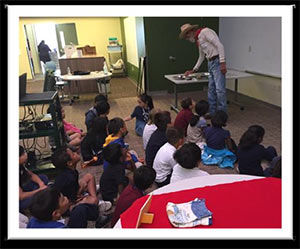
This year the Milpitas Historical Society started an educational outreach project whose first phase focuses on helping third graders in Milpitas’ elementary schools appreciate their local history. Our timing was fortunate because recently the Society received a request from Mrs. Jeannie Lam, third grade teacher at Sinnott Elementary School, asking for any support that the Society might provide about that subject.
What resulted through her coordination was a visit by the Society on September 21 to Sinnott in which a presentation was made to each of four classes — in all, over 100 students attended. Presentations to other schools are now being scheduled, including to Curtner School on November 30.
Prehistoric Times – Tour de California in 2008
Designed by Kraig Bunnell, the Society’s Director of Archives and Landmarks, the presentation entitled “Milpitas History” is truly multimedia, built around a PowerPoint slide show
containing 87 slides running 35-40 minutes in length. It spans Milpitas history from prehistoric times to as recently as the first Tour de California cycling race in 2008.
Historical Artifacts Grab 3rd Graders’ Attention
What really catches the attention of third graders are the many historical artifacts that Kraig has paired with the slides. The kids get to look at and touch physical objects such as replicas of prehistoric animals that swam in our waters and roamed our landscape, a real Indian stone spear point, an obsidian arrowhead, a stone gill hook for fishing, and the tools with which Muwekma Ohlone Indians created cooking and ceremonial fires.
There were examples of what life was like at Rancho Milpitas during the Spanish and then Mexican eras of the1700-1800s, samples of real gold (that generated some student wows) to connect them with the 1850 California Gold Rush period, and even collections of coins showing the changes in appearance of U.S. currency over time (including an early Spanish “Dolar” coin that circulated as legal U.S. currency until the 1850s), and on a separate display table, objects reflecting daily household life up to the early 1900s.
The PowerPoint show and the circulating artifacts are all tied together with Kraig’s colorful narration, and he attentively listens to and responds to questions raised by the students. Afterward, if any of the students missed seeing an object, they could pick up and look at the objects.
Comments are closed.